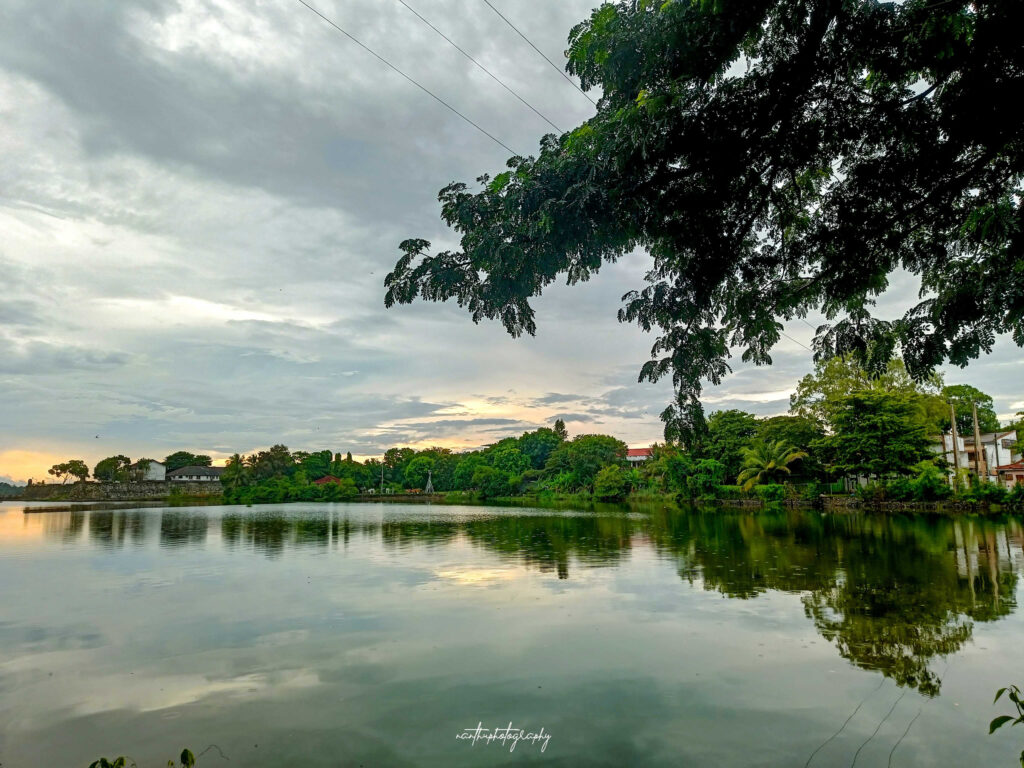இலங்கையின் கிழக்குப் பகுதியில் அமைந்துள்ள மட்டக்களப்பு நுழைவாயில் என்பது பெரிதாக அறியப்படாத ஒரு சிறிய நினைவுச்சின்னமாக இருந்தாலும், இதன் வரலாற்று முக்கியத்துவம், கலாசார பன்முகத்தன்மையின் முக்கியத்துவம் ஆகியவை மிகவும் தனித்துவமானவை. மட்டக்களப்பு நகரின் மையத்தில் அமைந்துள்ள இந்தக் கட்டமைப்பு, வெறும் நுழைவாயிலாக மட்டுமல்லாமல், ஒரு வரலாற்று கதையைத் கூறும் நுழைவாயிலாக இருக்கிறது.
வரலாற்றுப் பின்னணி
மட்டக்களப்பு நுழைவாயில், இலங்கையின் காலனித்துவக் காலத்தைச் சேர்ந்த ஒரு முக்கிய சின்னமாகும். 17ஆம் நூற்றாண்டின் தொடக்கத்தில் போர்த்துயர்கள் இவ்வைபாகத்தில் ஆட்சி செய்யத் தொடங்கினர். பின்னர், இந்த பகுதி டச்சு மற்றும் பிரிட்டிஷ் ஆட்சிக்குட்பட்டது. கிழக்குக் கரையில் உள்ள முக்கிய இடமாக மட்டக்களப்பு, கடல் பாதைகள், வாணிபம் மற்றும் இராணுவ ரீதியாக முக்கியத்துவம் வாய்ந்ததாக இருந்தது.
இந்தக் நுழைவாயில் முதலில் டச்சு ஆட்சியின்போது கட்டப்பட்டது. பின்னர், பிரிட்டிஷ் ஆட்சியின்போது சில மாற்றங்கள் செய்யப்பட்டன. இது பிரதான தரைவழியிலிருந்து புளியந்தீவுக்கு செல்லும் நுழைவாயிலாக இருந்தது. அப்போது, புளியந்தீவானது மட்டக்களப்பு கட்டுநீரின் (lagoon) காரணமாக பிரிந்த தீவாக இருந்தது. காலப்போக்கில் பாலங்கள் மற்றும் causeways கட்டப்பட்டாலும், இந்த நுழைவாயில் வரலாற்று சின்னமாகவே இருந்தது.
கட்டிடக்கலைச் சிறப்புகள்
மிகவும் எளிமையான அமைப்புடன் இருந்தாலும், மட்டக்களப்பு நுழைவாயிலின் வடிவமைப்பில் காலனித்துவக் கட்டிடக்கலைத் தாக்கங்கள் உள்ளன. கல் தூண்கள் மற்றும் வெண்கல மேடைகள் கொண்ட இந்த கட்டிடம், ஒரு பாதுகாப்பு மற்றும் சோதனைப் புள்ளியாகப் பயன்படுத்தப்பட்டது.
இன்றைய நிலையில், இங்கு சுத்தமாக்கல், நடைபாதைகள், மின்விளக்குகள் மற்றும் தகவல் பலகைகள் நிறுவப்பட்டுள்ளன. இது பார்வையாளர்களுக்காக அமைக்கப்பட்ட ஒரு சுத்தமான பொது இடமாக மாறியுள்ளது.
வரலாற்று முக்கியத்துவம்
இந்தக் நுழைவாயிலுடன் தொடர்புடைய மிக முக்கியமான வரலாற்றுப் பரிமாணம், ஆங்கிலேய மேதடிஸ்ட் மதபோதகர் வில்லியம் ஆல்ட் (Rev. William Ault) என்பவரது வருகைதான். 1814 ஆம் ஆண்டு அவர் இக்கதவின் வழியாக மட்டக்களப்பில் தங்கி, கிழக்குப் பகுதியில் முதன்முதலாக கிறிஸ்தவப் பிரசங்கத்தைத் தொடங்கினார். இதன் நினைவாக இங்கே அவரது நினைவுப் பலகை அமைக்கப்பட்டுள்ளது.
மேலும், இந்தக் நுழைவாயில் காலனித்துவ அதிகாரத்தின் ஒரு சின்னமாகவும் இருந்தது. நகருக்குள் நுழையும் வழியாக இது இருந்ததால், கட்டுப்பாட்டையும், அதே நேரத்தில் மாற்றத்தையும் குறிக்கிறது.
கலாசார ஒற்றுமை
மட்டக்களப்பு என்பது தமிழ், முஸ்லிம், சிங்கள, பெர்கர் என பல சமூகங்களை உள்ளடக்கிய கலாசாரக் கலவையைக் கொண்ட ஒரு நகரமாகும். இந்தக் கதவின் சுழற்சி பகுதி பல மதங்களை உள்ளடக்கிய பகுதியாகவும் இருக்கிறது. இது சமீபத்திய காலங்களில் கூட சமூக ஒற்றுமையின் சின்னமாகவே திகழ்கிறது.
நுழைவாயில் சுற்றி ஹிந்து கோவில்கள், கிறிஸ்தவ தேவாலயங்கள் மற்றும் மஸ்ஜித்கள் போன்ற மதபூர்வமான இடங்கள் உள்ளன. இது இந்த நகரத்தின் மத ஒற்றுமையையும், அமைதிப் புனரமைப்பையும் பிரதிபலிக்கிறது.
இயற்கை அழகு மற்றும் சுற்றுலா
மட்டக்களப்பு கட்டுநீரின் அருகே அமைந்துள்ள இந்தக் நுழைவாயிலின் இயற்கைச் சிறப்புகள் பார்வையாளர்களை கவருகின்றன. குறிப்பாக சூரிய உதயத்திலும் மறையும் நேரங்களிலும், நுழைவாயிலின் இடம் பார்வைக்கு அழகாகத் தெரிகிறது.
இந்தக் கதவிற்கு அருகில் உள்ள முக்கிய இடங்கள்:
- மட்டக்களப்பு கோட்டை – போர்த்துகீசர்கள் கட்டிய புகழ்பெற்ற கோட்டை.
- கல்லடி பாலம் – இரவில் இசை போல் ஒலிக்கும் “பாடும் மீன்கள்” பற்றிய கதைகளால் பிரசித்திபெற்றது.
- காந்தி பூங்கா – குடும்பத்தோடு சுற்றிப் பார்வையிட ஏற்ற பொது இடம்.
- மட்டக்களப்பு விளக்கக் கோபுரம் – கடல் மற்றும் கட்டுநீரைப் பார்வையிட ஏற்ற இடம்.
இந்த இடம் தற்போது உள்ளூர் மற்றும் வெளிநாட்டு சுற்றுலா பயணிகளால் விரும்பப் பெறப்படுகிறது.

பாதுகாப்பும் அபிவிருத்தியும்
அண்மைய காலங்களில், இவ்விடத்தின் வரலாற்று முக்கியத்துவத்தை பராமரிக்க உள்ளூர் நிர்வாகம் பல நடவடிக்கைகளை மேற்கொண்டுள்ளது. சுற்றுச்சூழலின் சுத்தம், விளக்குகள், தெரு கூடாரங்கள், கலாசார நிகழ்ச்சிகள் போன்றவை இங்கு ஏற்பாடு செய்யப்படுகின்றன.
மாணவர்களும் இளைஞர்களும் இங்கு புகைப்படங்கள் எடுக்க வருவதும், இது கல்வி மற்றும் பாரம்பரியத்தைப் புரிந்துகொள்ளும் இடமாக மாறுவதும் இது மீண்டும் முக்கியத்துவம் பெற காரணமாக இருக்கின்றன.
மட்டக்களப்பு நுழைவாயில் என்பது ஒரு சின்னமாக மட்டுமல்ல, இது கடந்த காலத்திலிருந்து இன்றைய நிலைமையை நோக்கி நகரும் ஒரு பாலமாகும். காலனித்துவத்திலிருந்து சுதந்திரத்திற்கு, பிரிவினையிலிருந்து ஒற்றுமைக்கு, இருண்ட காலத்திலிருந்து ஒளியூட்டும் எதிர்காலத்திற்கு வழிவகுக்கும் ஒரு நினைவாக இது திகழ்கிறது.
இது மட்டக்களப்பு மக்களுக்கு அவர்கள் வரலாற்றையும், பண்பாடுகளையும் நினைவுபடுத்துகிறது. மேலும், இன்று நாடு ஒற்றுமை மற்றும் அமைதி நோக்கி பயணிக்கும் நிலையில், இதுபோன்ற இடங்கள் மறக்க முடியாத அர்த்தங்களைக் கொண்டவை.
முடிவுரை
மட்டக்களப்பு நுழைவாயில் என்பது பெரிதாக உயர்ந்த நினைவுச்சின்னம் அல்லவாகினும், அதன் பின்னணி மிகுந்த முக்கியத்துவம் வாய்ந்தது. வரலாற்று நினைவாகவும், மத ஒற்றுமையின் சின்னமாகவும், சுற்றுலா மையமாகவும் இது உயர்ந்துள்ளது.
இதை பாதுகாக்கும் முயற்சிகள் தொடரும் பட்சத்தில், இது எதிர்கால சந்ததிகளுக்கு கல்வி மற்றும் கலாசார பாரம்பரியத்தை எடுத்துச் சொல்லும் ஓர் உயிரோட்டமான நினைவாகவே திகழும்.
மேலதிக தகவல்களுக்கு மாற்றம் செய்திகள்
The Batticaloa Gate: A Symbol of History and Unity
Nestled in the heart of Sri Lanka’s Eastern Province, the Batticaloa Gate may appear as a small and lesser-known landmark, but its historical relevance, architectural uniqueness, and socio-cultural symbolism make it a profound emblem of resilience, transformation, and unity.
While often overlooked in mainstream heritage tourism circuits, the Batticaloa Gate stands not merely as a remnant of the past but as a silent storyteller — whispering tales of colonial encounters, interfaith harmony, and the evolving identity of Batticaloa town itself.
Historical Background
The origins of the Batticaloa Gate can be traced back to the colonial period, particularly to the Dutch era in the early 17th century. The Portuguese were the first European power to establish control over the Batticaloa region, primarily because of its strategic position along the eastern seaboard. Later, the Dutch East India Company (VOC) ousted the Portuguese and strengthened their influence by building forts, trade posts, and checkpoints — one of which would become known as the Batticaloa Gate.
Under British rule, the structure was slightly modified and continued to serve as a crucial access point from the mainland to Puliyanthivu, which at that time was more isolated due to the lagoon that surrounded it. Though causeways and bridges have since changed the island’s connectivity, the gate retains its historical status as a frontier — both literal and metaphorical.
It was not only a physical checkpoint for entering the town but also served as a symbolic threshold, representing the transition from colonial authority to local governance over time.
Architectural Features
Despite its simple design, the Batticaloa Gate showcases elements of colonial-era architecture. Built using stone pillars, iron framework, and subtle masonry, the structure once functioned as a military checkpoint and customs post, monitoring goods and people entering Puliyanthivu.
Today, the gate has undergone restoration and beautification. The surrounding area features:
- Cleaned walkways
- Proper lighting for nighttime visitors
- Informational plaques explaining the site’s significance
- Benches and green spaces to promote public interaction
This transformation has elevated the gate from a relic to a community landmark, encouraging both locals and tourists to engage with its history.
Religious and Historical Significance
One of the most remarkable events associated with the Batticaloa Gate is the arrival of Rev. William Ault, a Methodist missionary from England. In 1814, Rev. Ault disembarked near this very site and began his work in spreading Christianity in the Eastern Province. His legacy remains intact through a commemorative plaque placed near the gate, which honors his contribution to religious education and humanitarian work in the region.
This landmark, therefore, does not merely represent a colonial boundary but also a gateway to ideological and cultural exchange. The entry of Rev. Ault marks a moment in history when Batticaloa became a melting pot for diverse spiritual teachings and inter-religious discourse.

Symbol of Cultural Harmony
Batticaloa town is known for its rich cultural mosaic — comprising Tamil Hindus, Sri Lankan Moors (Muslims), Sinhalese Buddhists, Christians, and even descendants of Portuguese Burghers. The surroundings of the Batticaloa Gate are reflective of this religious and ethnic diversity.
Within close proximity of the gate, one can find:
- Hindu temples such as the Sri Manikka Pillaiyar Kovil
- Christian churches, including old Methodist and Catholic churches
- Mosques serving the local Muslim community
This religious coexistence, despite the region’s turbulent history, stands as a living testament to tolerance and peace-building. Over the years, the gate has evolved into a symbol of unity in diversity, echoing the city’s ability to accommodate difference while maintaining its identity.
Natural Beauty and Tourism Potential
Situated beside the serene Batticaloa Lagoon, the Batticaloa Gate offers a picturesque view, particularly during sunrise and sunset when the golden hues reflect over the calm waters. The area is favored by photographers, tourists, couples, and students alike — often drawn by its romantic charm and tranquil ambiance.
Nearby attractions include:
- 🏰 Batticaloa Fort – Originally built by the Portuguese and later expanded by the Dutch, this fort offers a glimpse into Sri Lanka’s colonial past.
- 🌉 Kallady Bridge – Famous for its “singing fish” — an acoustic phenomenon described in folklore and occasionally recorded under specific conditions.
- 🌺 Gandhi Park – A beautifully maintained park ideal for families, morning walks, and community events.
- 🌊 Batticaloa Lighthouse – Offers panoramic views of the ocean and lagoon; a quiet spot perfect for reflection or photography.
With tourism steadily growing in the Eastern Province, especially post-civil war, such heritage landmarks play a vital role in rebranding Batticaloa as a peaceful, culturally rich, and environmentally stunning destination.
Preservation and Community Engagement
In recent years, local government bodies and NGOs have taken steps to preserve and revitalize the Batticaloa Gate. These include:
- Restoration of stonework
- Installation of LED lighting and seating areas
- Hosting cultural festivals and educational tours
- Creating awareness campaigns about the site’s significance among school children
The involvement of students and youth, particularly through photography, storytelling, and art projects, has turned this place into a living classroom — connecting younger generations with their heritage.
A Bridge Across Time
More than just an old colonial gate, the Batticaloa Gate serves as a metaphorical bridge between the past and the present. From colonization to independence, from division to unity, from obscurity to recognition — the gate mirrors Batticaloa’s journey through time.
It reminds the people of their shared histories, cultural resilience, and the power of memory in shaping identity. As Sri Lanka continues to strive toward national reconciliation and peaceful coexistence, sites like the Batticaloa Gate carry immense symbolic weight.
Conclusion
Though modest in stature, the Batticaloa Gate carries a legacy far greater than its size. It embodies a narrative of endurance, openness, and unity. As long as efforts continue to maintain and celebrate it, the gate will not only remain a part of the physical landscape but will also live on as a heritage beacon for future generations.
Let it remind us that every gate is not just an entrance — sometimes, it’s a passage to understanding, connection, and healing.
For more Articles visit Maatram News



